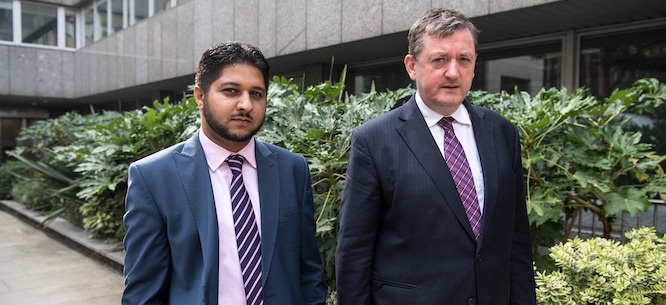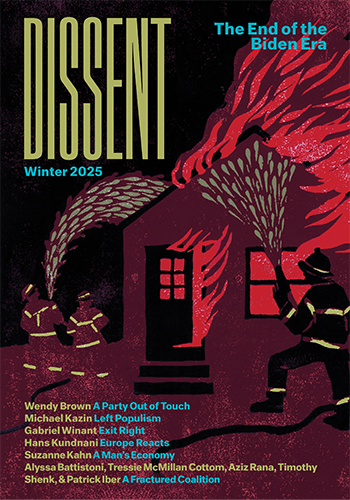The Workers Who Sued Uber and Won
The Workers Who Sued Uber and Won
The UK Supreme Court has ruled in favor of Uber drivers, declaring them workers and not independent contractors. But to beat the platform capitalists, it is urgent that we start to treat digital rights as worker rights.

In February, the UK Supreme Court ruled unanimously in Uber BV v. Aslam that Uber drivers should be classified not as independent contractors but as workers entitled to basic employment protections like the minimum wage and paid annual leave. The landmark ruling is an inflection point for gig worker–led movements around the world. In April, U.S. Secretary of Labor Marty Walsh said that gig workers should be considered employees, another sign that the tide is turning.
But court victories alone aren’t enough to protect workers. Across the world, companies like Uber are using algorithmic control to remain one step ahead of regulators, adopting new technologies to disguise old-fashioned exploitation.
To understand the significance of the UK ruling and the road ahead for gig workers, I interviewed James Farrar, one of the lead claimants in Uber BV v. Aslam. Farrar is a former Uber driver who cofounded the App Drivers and Couriers Union and leads the nonprofit Worker Info Exchange—two groups on the forefront of resistance against Uber in Europe. As Farrar explains, to win against platform capitalists, it is urgent that we start to treat digital rights as worker rights.
This interview has been edited and condensed for clarity.
Wilfred Chan: How did your fight against Uber begin, and how did it end up at the UK Supreme Court?
James Farrar: It started with me and Yaseen Aslam, in 2015. Yaseen had been driving for Uber from quite early on. He was making reasonably good money at the beginning, because that’s the way these networks operate. They suck in a lot of people with incentives to keep you on the road and to get your friends involved. And then, like drug dealers, they start to reel it back from you once you’re hooked. Driver incomes were coming down as new drivers were flooding the platform. Yaseen was beginning to organize drivers to put pressure on Uber. They were meeting in parks in East London; nobody had any money to do anything.
Around that time I left a job at a tech company and began driving Uber to supplement my income. A few weeks in, I was assaulted on the job. I thought, at least it’s a digital app, it will be very easy for the police to track down who did this. I contacted Uber to tell them the police wanted to know who the customer was, and they said they couldn’t tell me for data protection reasons. I said, “But it’s my customer, isn’t it? I mean, you told me that you’re the agent and I’m the principal in this business. So surely you can tell me who my customer is.” They said no.
So I started asking who I was working for. What was going on here? When I looked at the contract, I understood what the problem was. The contractual arrangement was between me and the customer directly, and Uber was acting as my agent, while not accepting any of the risk. I believe Uber did that for three reasons. First, it didn’t want to trigger any public liability that could make it responsible for anything bad that might happen during the journey. Second, it didn’t want to trigger an employment liability to me by expressing any kind of duty of care. And third, it didn’t want to trigger VAT [value-added tax] liability. Uber claims the VAT taxable supply is with the driver, who falls below the VAT threshold of £85,000. So nobody pays the VAT.
And then I met Yaseen. He heard about my assault, and we started collaborating. We phoned the law firm Leigh Day, and they came up with the idea that there is a bottom-rung employment status in the UK, “worker” status, which sits between full employee and being truly self-employed. That’s what we aimed for, and that’s where the case started. We won it in 2016. Uber appealed it in 2017, we won that. We went to the Court of Appeal in late 2018, and we won that. And then Uber’s whole house of cards came down at the Supreme Court in February. Now it has to express employment responsibility of some kind. And it also now owes the Treasury at least £500 million in VAT back payment.
Chan: How did it feel to finally get that result after all those years?
Farrar: The best part wasn’t just winning, but the way we won. It was a six-nil, unanimous decision. That’s a very strong mandate from the court, a very strong rebuke of Uber.
We weren’t sure how this was going to go because our initial win in 2016 was at an employment tribunal, which is quite a junior court setting. And then it escalated, through the Employment Appeals Tribunal, Court of Appeal, to the Supreme Court. The highest court in the land isn’t really bothered about me and Yaseen and minicabs, but they were very interested in the point of law that was being appealed.
It was really a titanic battle between contract law—the way businesses depend on the sanctity of contracts to do business—versus worker rights. And there was a case that launched us to the Supreme Court, a previous Supreme Court ruling called Autoclenz Ltd. v. Belcher.
Chan: What happened with Autoclenz?
Farrar: You had a bunch of guys who were car valets, washing cars for a big car auction company that had a clever lawyer. They would march these poor guys in and out of the office every five minutes to sign new contracts and addendums. They were trying to maintain this fiction that these guys were self-employed and therefore should not trigger PAYE—our national insurance contributions on behalf of the employer. They wanted basically the ability to employ and command people but not to have any employment costs or responsibilities to go with that.
Sometimes the employment tribunals are like divorce courts. In order to assert employment rights, the first thing you have to do is prove that you were in the relationship. I’d say to Uber, “We’re in a relationship.” And they were like, “No, no, we’re not we’re not in a relationship.” I haven’t had that problem since I was in high school.
So when Autoclenz came before the courts, the judges saw these contracts that were too clever by half. They took what’s called a purposive approach: they decided that there was an employment relationship, not based on the contract, but based on the evidence that was put in front of him.
And that is what propelled our Uber case to the Supreme Court. At every level, Uber came in with these contracts to say that we are not employees—we are our own bosses, micro-entrepreneurs. And at each level, it was thrown out on the basis of Autoclenz.
Uber argued that Autoclenz had gone too far and we must preserve the sanctity of contracts. But the court went the other way, saying that this is not contract law but an abuse. What I’ve found emotional was they said the purpose of labor legislation is to protect vulnerable workers. And so if the purpose of your contracts is to disqualify vulnerable workers from the statutory protections they would otherwise have and need, and you’ve done this through classification purposes, then that won’t stand in law. We will throw those contracts out. The moral clarity in that is amazing.
Chan: Uber has agreed to classify its UK drivers as “workers,” but it still refuses to fully comply with the ruling.
Farrar: The Supreme Court had to decide two questions. Were we workers and, if so, when were we workers? What is the working time? The original tribunal said we were workers from when we log on to the app to when we log off. The Supreme Court agreed.
Uber has ignored all that. They are only observing working time from the point of dispatch to drop off. That means about 40 to 50 percent of your working time is not protected.
Chan: This reminds me of how Uber completely ignored California’s AB5, which reclassified gig workers as employees, after it was signed into law and upheld by the state Supreme Court.
Farrar: It’s amazing, isn’t it? It’s amazing they can actually defy the law that way. You and I can’t get away with doing that.
Chan: How does the ruling affect drivers who work for multiple apps?
Farrar: The Supreme Court kicked the can down the road, because there were no other apps in the market back when we took up the case. But it’s an issue. That’s going to have to be relitigated, and we’re going to have to bring these cases forward on the working time issue.
Chan: What’s next after this case?
Farrar: What’s clear to me is that using contracts as a means of worker control is dead—the Supreme Court killed that here. What’s next is the issue of data and algorithmic control, which is part of the misclassification game.
With misclassification, we’re like a dysfunctional couple that can’t talk about the relationship we’re in. We’ve got to call a job an “economic opportunity.” We’ve got to call recruitment “onboarding.” We have to use all these words to misdescribe what’s really happening. What’s even more effective is if we use algorithmic control rather than words at all.
These apps guide our behavior through incentives and punishment. If they do it through electronic nudges, then they don’t need to say it. And if you don’t get the message, that’s okay—you’ll just starve. It’s an expression of management practice and control, which means there is an employment relationship. So it is very important for us to reveal that algorithmic control.
Chan: How?
Farrar: There are three distinct aspects to our battle for data.
The first is the right to access data. We have the absolute right to all our personal data packets, in a machine-readable format. We can reassemble that in a data trust and immediately answer a few important questions. How much did I earn? How was my time utilized on the platform? What was the quality and quantity of work I was offered? And if I was fired, why was I fired? We could have the answers to these questions relative to our peer group as well. This is really important in terms of organizing labor and collectivizing action: the ability to bring people together around their data.
The second aspect is the transparency of algorithmic management, in the parlance of the EU General Data Protection Regulation (GDPR). It’s an EU directive, and nation-states are obliged to enact it into their own law. Even though Britain has exited the EU, the Data Protection Act of 2018 encapsulates the GDPR just as much in Britain as it does in the EU. That means we have this right to access our data, but we also have the right to access the logic of processing, an old-fashioned tech phrase for revealing algorithms and control.
It’s a bit like going for an MRI. You get this injection of dye into your body and then you can see how the blood has been processed through your organs to see how they’re working. I’ve got my data, which is my blood. But with the logic of processing now I understand how it was processed through the platform. That tells me how I was managed.
The third aspect is the ability to challenge automated decision-making that creates negative legal effects. This is Article 22 of the GDPR. There are certain automated decisions that could be harmful to workers, particularly around work allocation, performance management, and dismissals. We’ve taken a range of cases against Uber, and we’ve got some interesting results already.
Chan: What’s happening with the Article 22 cases?
Farrar: Under Article 22, you have certain protections. You’ve got the right to appeal, you’ve got the right to human intervention, and you’ve got the right to put your point of view across. These are weak rights, but they’re rights nonetheless. They give me the right to stop the machine. These platforms don’t want to admit to this because it would give people rights to intervene that the companies don’t want them to have.
We brought a bunch of Article 22 claims against Uber in Amsterdam. In March, Uber was ordered to reveal the data used as the basis for unfair dismissal of two drivers that were accused of fraudulent activity. Fraud is used very loosely, but we think it often is a disguise for performance-related dismissal.
One driver who was deactivated by Uber for fraud also had his license revoked by Transport for London. So he not only lost his job but his livelihood.
We challenged Uber’s decisions, Uber never defended them, and in April we got default judgments. This was the first time in Europe that we got a judge to overturn what is essentially a robo-firing of drivers by a platform. And the court ordered that they be reinstated, that they receive compensation, and that Uber has to pay pecuniary damages.
It is a way for us to park our tanks on their lawn. To plant a flag on their platform to bring some transparency. It’ll be an iterative game, because they’re always going to be hiding new systems from us. But if we shine some light on it, we can learn more about how these platforms work. That’s the kind trench warfare we’re going to be engaged in for the future.
Chan: How does the Worker Information Exchange come into play?
Farrar: The reason we set it up was because I realized workers would have to have control of the data if they were going to be able to compete with Uber.
The other part of this is to run the public policy debate, because Uber has control of all this traffic data. Drivers have none. Uber has in New York and in London argued for road pricing [congestion pricing in the United States] rather than licensing caps, on the argument that the market is a more efficient way of dealing with congestion. But because of the network effects of Uber, they build market share in a road pricing environment. And the reality is because of Uber’s power over labor, more of the cost will be passed on to drivers. So we can show policymakers that even in a smart road pricing scenario, Uber is still going to oversupply the market, cause congestion and dump the cost onto somebody else. We need road pricing, but we need capping as well.
I recognize from going to court over seven years that the legal solution is inefficient and chancy. We can’t expect miracles in the courtroom. And sometimes even the laws are not there to protect us anyway. So our goal is to put the power of that data in in the hands of workers, to build the collective bargaining power of drivers.
Chan: What would you say to American workers about our fight ahead?
Farrar: You’re moving in the right direction with the California Consumer Privacy Act. But in Europe and in America, the world of data protection has been an individualistic game. It’s about usually well-educated and quite affluent people who are trying to protect their personal privacy.
We need to evolve our data protection laws to include the collective right of workers to access data, and to have transparency about how they’ve been managed by a platform. Once we understand that, we can assert our digital rights and our worker rights.
Wilfred Chan is a contributing writer to The Nation and a freelance journalist based in New York City.
James Farrar is the cofounder of the App Drivers and Couriers Union and leads the nonprofit Worker Info Exchange.




